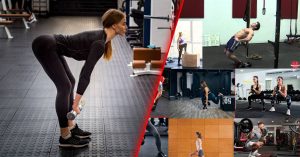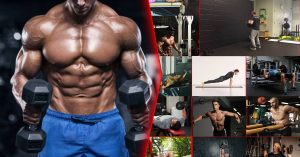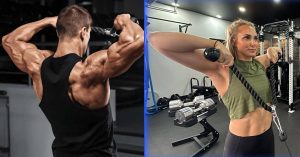You are not the only person who searches online to find the Best Strength Training Exercises to level up your game as a swimmer. It’s a well-known fact that swimmers can have good benefits from strength training exercises targeting the same muscles used in their swimming.
We’ve got the lowdown on the best strength exercises designed especially for you. Whether you’re a pro racer or just love a good swim, having strength in all the right places can make a huge splash in your performance.
So, let’s dive into some simple yet super effective exercises that’ll have you gliding through the water like a champ. Ready? Let’s go!
Table of contents
MORE keyboard_double_arrow_down LESS keyboard_double_arrow_up
What is Strength Training for Swimmers?
Strength training for swimmers is a specialized regimen designed to enhance muscular strength, power, and endurance specifically tailored to the demands of swimming. It targets key muscle groups involved in swimming movements, such as the shoulders, back, chest, core, and legs, aiming to improve propulsion, technique, and injury prevention.
This form of training helps swimmers develop the strength and stability needed to excel in the water, ultimately leading to faster times and improved performance. Now, let’s dive into why it is essential to have a comprehensive strength training program for swimmers.
Why Is Strength Training for Swimmers Important?
Before we get into the exercises, let’s talk about why being strong matters for swimmers. It’s not just about looking buff; it’s about being better in the water. Strong muscles help you swim faster, prevent injuries, and keep you going longer.
We all know consistency is the key to getting better at any sport, especially if you wish to improve your swimming skills further. Plus, continuous training will make you disciplined and focused. This is a much needed factor to increase your chance of getting better every season.
Here are some reasons that will help you understand why Strength training is crucial for swimmers of all levels.
1. Boosts Performance:
Strength training for swimmers isn’t just about getting stronger; it’s about unlocking your full potential in the water.
Here’s how including these exercises in your weekly training schedule can help to boost your overall performance in swimming:
- Increase Power and Speed: Swimming requires powerful movements to propel yourself through the water. Strength training increases muscle mass and strength, allowing for stronger pulls, kicks, and starts, ultimately leading to faster swimming speeds.
- Improved Technique: Stronger muscles enable better control and coordination, leading to a more efficient and technically sound stroke. This translates to less wasted energy and smoother movements, maximizing performance.
- Starts and Turns: Starts and turns are crucial moments in competitive swimming. Strength training specifically targeting core and leg muscles allows for explosiveness and power needed for faster starts and tighter turns.
2. Reduces Injury Risk:
Swimming is undoubtedly a fantastic full-body workout, but all that repetitive motion can sometimes lead to unwanted aches and pains.
Here’s how including strength training into your routine can help keep those injuries at bay:
- Repetitive Strain: Swimming involves repetitive motions that can strain muscles and joints. Strength training strengthens supporting muscles, relieves stress on overworked areas, and improves overall stability, reducing the risk of overuse injuries.
- Joint Protection: Stronger muscles provide better joint support, protecting vulnerable areas like shoulders, knees, and hips from wear and tear caused by high-impact movements.
- Enhanced Endurance: While swimming primarily relies on aerobic endurance, incorporating strength training can improve overall endurance by delaying the onset of muscle fatigue. Stronger muscles can maintain proper technique and form for longer periods, allowing swimmers to swim more efficiently.
- Core Stability: A strong core is crucial for maintaining proper body position and stability in the water. Strength training exercises that target the core muscles help swimmers maintain a streamlined position and reduce drag, leading to faster swim times.
- Increased Muscle Efficiency: Strength training can improve neuromuscular coordination, making muscles more efficient in their movements. This efficiency can lead to smoother and more coordinated swimming strokes.
- Mental Toughness: Strength training requires discipline, focus, and perseverance, all of which are valuable mental attributes for swimmers. Incorporating strength training into their regimen can help swimmers develop mental toughness that can be beneficial both in and out of the pool.
As you can see, swimmers can unlock their full potential by incorporating strength training into their routine. Hence they may,
- Achieve faster times,
- Reduce injury risk, and enjoy healthier,
- More fulfilling swimming experiences.
Now, let us dive into our main topic, what are the Strength Training exercises you could do to improve your swimming skills?
16 Best Strength Training Exercises for Swimmers.
Depending on which body sections will get an impact from these 16 Strength Training Exercises, all of them can be divided into 3 main categories, such as Upper Body, Lower Body, and Core.
So, let us discuss further as below.
#1: Upper Body
Your upper body is your powerhouse when it comes to swimming. Strengthening these muscles not only enhances your stroke power but also ensures better technique and injury prevention. Let’s explore some key exercises tailored to boost your upper body strength and propel you through the water with ease:
1. Pull-ups/Chin-ups:
These classic exercises build pulling strength in your back and biceps, crucial for powerful strokes. Whether you’re aiming for powerful strokes or a stronger back and biceps, pull-ups and chin-ups are your go-to exercises.
With variations like assisted pull-ups or lat pulldowns, you can tailor your workout to match your current fitness level.
2. Dumbbell rows:
To do this exercise you need to engage your back and shoulder muscles with various rowing variations like seated rows, single-arm rows, or chest-supported rows. Doesn’t matter whether you opt for seated rows or single-arm rows, this exercise will improve the catch and pull phases of your swimming stroke.
3. Push-ups (various):
A strong chest, triceps, and shoulders are essential for efficient strokes and powerful pushes off the wall.
This exercise helps to strengthen your chest, triceps, and shoulders with different push-up options like incline push-ups, knee push-ups, or wall push-ups. This improves pushing power and overall stroke technique.
4. Overhead press:
Shoulder strength and stability are crucial for maintaining proper stroke mechanics and preventing injury.
You can develop shoulder strength and stability with overhead presses using dumbbells, barbells, or kettlebells. This helps you to develop better stroke mechanics and prevents injuries.
5. Reverse Fly:
Strengthening your shoulders and upper back not only improves your stroke mechanics but also enhances your posture in and out of the water. For that, you can use this exercise to target your shoulders and upper back muscles, improving stroke mechanics and posture. You can use dumbbells or resistance bands for variations.
#2: Lower Body:
Your lower body is the engine that drives you through the water, powering your kicks and explosive starts. Strengthening these muscles not only enhances your speed but also improves your stability and agility in the pool.
Let’s explore some key exercises tailored to boost your lower body strength and take your swimming to new heights:
6. Squats:
Building leg strength is essential for generating powerful kicks and explosive starts off the block. Start with bodyweight squats to master the form, then gradually add weight as you progress. With each squat, you’ll be laying the foundation for faster swim times and stronger strokes.
7. Lunges:
Improve leg stability and balance, which are essential for underwater dolphin kicks and turns. Incorporate walking lunges, stationary lunges, or reverse lunges into your routine to improve your lower body control and agility in the water.
8. Calf raises:
Your calf muscles play a vital role in executing powerful flutter kicks and generating explosiveness during starts and turns. Strengthen them with calf raises, focusing on both single-leg and double-leg variations for a well-rounded workout that enhances your swimming performance.
9. Squat Jumps:
Develop explosive power for starts and dives with this dynamic exercise. This dynamic exercise helps develop the explosive strength needed to propel yourself off the block with speed and precision. Incorporate squat jumps into your training regimen to take your swimming to the next level.
#3: Core:
A strong core is the foundation of a powerful swim stroke, providing stability, balance, and rotational power.
Let’s explore a variety of exercises that target your core muscles and help you excel in the water:
10. Plank:
Engage your core muscles and build stability with variations like high plank, side plank, and plank with leg raises. These exercises promote proper body alignment and prevent injuries during swimming.
11. Dead bug:
Strengthen your core and lower back muscles with the dead bug exercise, which helps stabilize your spine and prevent back pain.
12. Bird dog:
Improve core stability and coordination, beneficial for overall stroke mechanics and injury prevention.
13. Mountain Climbers:
Engage your core, legs, and shoulders with mountain climbers, a full-body workout that mimics swimming motions and boosts your endurance in the water.
14. Russian Twists with Medicine Ball:
This exercise strengthens your obliques and core for rotational stability and power, crucial for executing turns and maintaining proper body position in the water.
15. Medicine Ball Lunge with Rotation:
This exercise combines lunges with rotational core engagement to mimic the twisting motion in strokes like a butterfly, enhancing your rotational power and stroke efficiency.
16. Chop Wood:
Develop rotational power and core stability with exercises like the wood chop, using a cable machine, medicine ball, or dumbbell to simulate the twisting motion required for starts and turns.
Quotes from Experts and Coaches About Strength Training for Swimmers:
Below are some quotes taken directly from experts and coaches that underline the critical role of strength training in enhancing swimming performance.
- Fares Ksebati: “Strength training was definitely a key component in my training. It helped me stay injury-free and gave me that extra power and explosiveness in the water.” (Source: Fares Ksebati Yt channel)
- Coley Stickels, Indiana University Swimming Coach: “Strength training is not an option, it’s a necessity. It’s the foundation for everything we do in the water.” (Source: theraceclubYt Channel)
- Scott Pollock, Senior Strength and Conditioning Coach & National Technical lead: “Historically competitive swimmers have trained to improve swim performance by swimming frequently, for long durations at various intensities. Recently elite swimmers have looked outside the pool for training methods which may offer additional benefits to performance beyond those which can be gained from swimming alone. One such training method is strength training.”(Source:his LinkedIn page)
Conclusion: Last Thoughts on Strength Training for Swimmers
To wrap things up, remember a few important tips for your strength training journey.
- It’s not compulsory to try out all the exercises mentioned in this article at once.
- Instead, Consider getting advice from a coach or trainer. They can help you figure out the best exercises for you and make sure you’re on the right track.
- Make sure to warm up properly before each workout with stretches and light cardio. This helps prevent injuries and gets your muscles ready for action.
- Next, always focus on doing exercises with the right form and technique. Don’t worry too much about lifting heavy weights. It’s more important to do things correctly to avoid hurting yourself.
- Also, listen to your body. If you feel tired or sore, take a break. Overdoing it can lead to problems, so be sure to rest when you need it.
So, keep these tips in mind as you work on getting stronger for swimming. Stay safe, take it slow, and have fun!
Key Points: Strength Training for Swimmers
- You need to include squats, pull-ups, glute bridges, broad jumps, planks, reverse fly, and chop wood into strength training routines for optimal swimming performance.
- All swimmers are encouraged to learn from failures and challenges, fostering resilience and perseverance, which are crucial for long-term success in swimming.
- A balanced training schedule includes 50-60 minutes of weight training every alternate day, targeting two muscle groups per session, combined with 50 minutes of swimming five days a week.
- You need to utilize a mix of strength training exercises targeting different muscle groups to ensure a well-rounded development of strength, endurance, and swimming technique.
- You need to use correct techniques and take safety measures at all times in both gym and pool workouts to prevent injuries and ensure effective training.
- You can customize your strength training routines to align with your swimming goals, strengths, and areas needing improvement.
FAQs
How do you build strength for swimming?
Building strength for swimming involves a combination of exercises that target key muscle groups used in swimming. Some of the best strength training exercises for swimmers include:
- Squats: Essential for leg strength, helping swimmers with propulsion in the pool.
- Pull-ups: Target the upper body muscles vital for effective stroke movement.
- Glute Bridges: Strengthen the glutes, crucial for powerful kicks.
- Broad Jumps: Improve explosive power, beneficial for starts and turns.
- Planks: Build core strength, important for stability and efficiency in the water.
- Reverse Fly: Enhance shoulder and upper back strength, contributing to stroke power.
- Chop Wood: Develop core and rotational strength, aiding in stroke dynamics.
How should a swimmer train in the gym?
Swimmers should focus on gym exercises that complement their swimming training. Key exercises include:
- Lateral Lunge: Targets muscles used in freestyle and enhances leg strength.
- Leg Cradle: Improves hip mobility, essential for efficient kicks.
- Pullups: Strengthen the back and shoulders for better stroke execution.
- Squat Jump: Builds leg power, aiding in explosive starts and turns.
- Medicine Ball Throw: Develops upper body strength and power.
What gym exercises are best for swimmers?
The best gym exercises for swimmers are those that enhance the muscles and movements used in swimming. These include:
- Lateral Lunges: Beneficial for freestyle stroke.
- Leg Cradle: Aids in hip flexibility.
- Pullups: Strengthens upper body for better strokes.
- Squat Jump: Improves overall leg power.
- Medicine Ball Throw: Enhances upper body strength.
How do you raise a strong swimmer?
Raising a strong swimmer involves more than just physical training; it includes fostering resilience. Allow swimmers to experience failure and learn from it. Encourage them to get back up and strive for success, teaching them valuable lessons in perseverance and self-improvement.
Protecting them from every challenge doesn’t aid their development; facing and overcoming obstacles does.
How do you balance gym and swimming?
Balancing gym and swimming involves a strategic approach to training:
- Gym Training: Engage in weight training for about 50-60 minutes every alternate day, targeting two muscle groups per session.
- Swimming: Dedicate around 50 minutes to swimming 5 days a week.
- Sequence: Follow up gym sessions with swimming to maximize benefits and recovery.
This balance ensures a comprehensive approach to strength and swimming training, enhancing overall performance.

ABOUT THE AUTHOR
Follow Valen Steven for a dose of fitness enthusiasm, evidence-based advice, and a roadmap to achieving your health and wellness goals.
Subscribe to our Newsletter
Dive into a world of fitness and wellness with our exclusive newsletter! Sign up now and receive weekly power-packs of fitness wisdom




